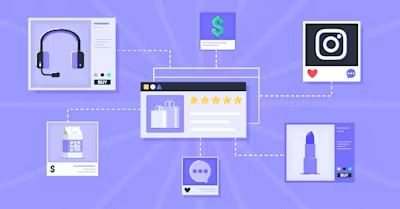
Looking to incorporate omnichannel ecommerce into your business strategy, but not quite sure where to start? We’ve got you covered. This blog post will guide you through the basics of omnichannel commerce and how it differs from a multichannel approach. We'll also explore the numerous benefits of utilizing an omnichannel approach and examine some real-world examples of businesses that have successfully leveraged it to their advantage. Finally, we'll discuss how businesses can optimize their omnichannel ecommerce strategy with the respond.io platform.
What is Omnichannel Ecommerce?
Omnichannel ecommerce aims to create a holistic shopping experience for customers across multiple platforms, both online and offline. Customers can interact with a brand through various touchpoints, such as a website, messaging apps and physical stores, and receive a consistent and personalized experience at every step.
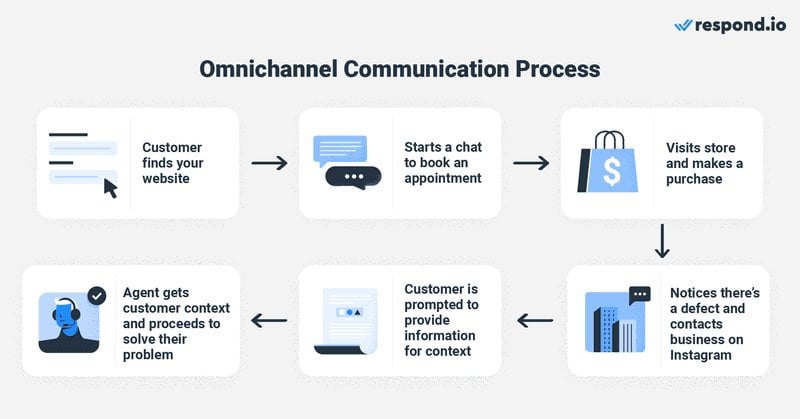
For example, a customer may seek product consultation or support over Facebook Messenger, WhatsApp, Instagram or WeChat, and then complete the purchase on a desktop or website.
To better understand omnichannel in ecommerce, let’s compare it to a multichannel strategy.
Omnichannel vs Multichannel Ecommerce: The Differences
In this section, we'll compare multichannel and omnichannel communication approaches to help businesses decide which is best for their customer engagement.
Multichannel ecommerce involves selling through multiple channels, both online and offline, which offers several benefits to businesses. The ability to diversify sales across various channels is one of the key advantages of this strategy. It reduces dependence on any single channel and potentially increases revenue streams.
Additionally, multichannel ecommerce can increase brand exposure and sales opportunities while offering customers flexibility. However, since these channels are not integrated, they can lead to a fragmented customer experience.
Retail Strategy | Advantages | Disadvantages |
|---|---|---|
Multichannel | Offers customers more options for engagement | Inconsistent customer experience due to disconnected channels |
Omnichannel | Wide audience reach | Requires tech investment to integrate all channels and customer data |
For instance, if a customer schedules a repair appointment for an item via Instagram but the store is unaware of the arrangement, it can result in frustration and a poor customer experience.
Omnichannel ecommerce, on the other hand, integrates all channels to offer a seamless and unified customer experience. This requires ecommerce businesses to invest in technology and processes to integrate data and deliver personalized customer services.
However, the effort is worth it. Let's explore the advantages of implementing an omnichannel strategy for ecommerce and retail businesses.
Benefits of Omnichannel Commerce
Retailers can reap multiple benefits by adopting an omnichannel ecommerce approach. Engaging with customers on their preferred channels can boost customer engagement and satisfaction. This can result in increased customer retention and higher sales.
Omnichannel ecommerce also provides a seamless and consistent shopping experience across all channels, building customer trust and increasing customer satisfaction and retention.
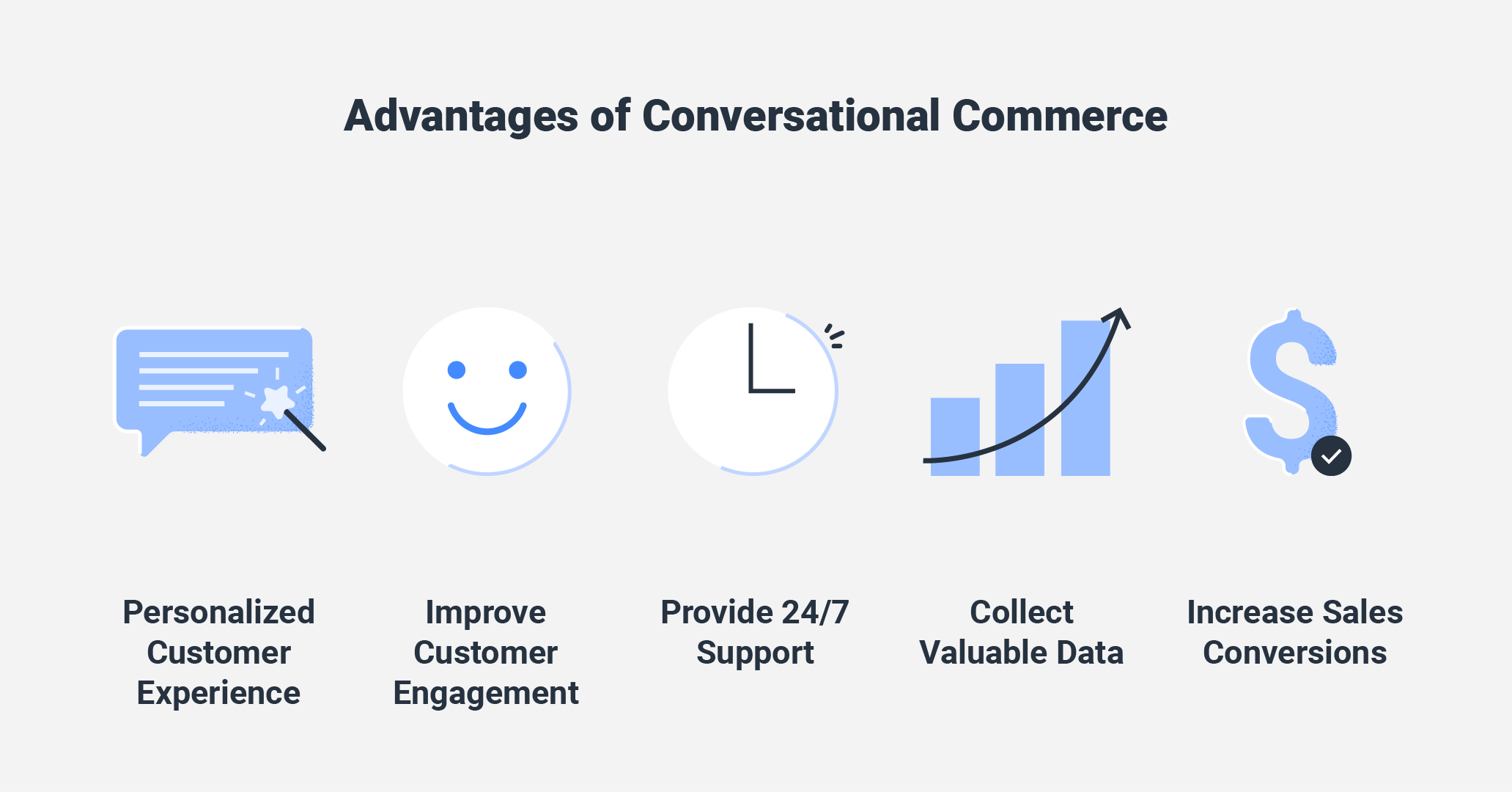
It can help businesses reach a wider audience and improve conversion rates, leading to increased sales and revenue. Offering convenient and personalized customer experiences also helps them stand out in a competitive landscape.
Integrating data from multiple channels provides a holistic view of customer behavior and preferences for data-driven decisions. This can be used to improve the customer journey and drive business growth.
Next, we’ll share three businesses that successfully implemented omnichannel strategies to enhance the customer experience, boost sales and stay competitive in today's market.
Omnichannel Ecommerce Examples: How 3 Businesses are Winning the Game
Here are three real-life examples of businesses using omnichannel ecommerce to improve customer engagement, increase sales and offer better customer support.
Yoho
Hong Kong’s largest e-commerce platform, Yoho, was struggling to provide efficient and personalized customer support. It needed a solution to manage customer inquiries on multiple messaging channels and automate some of its customer service tasks.
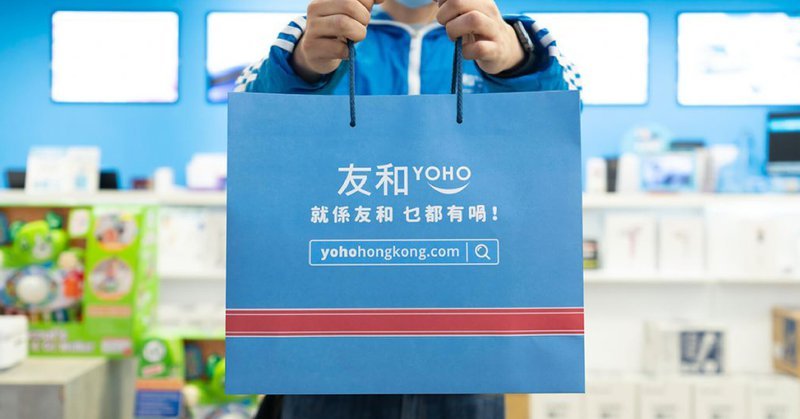
Respond.io consolidated Yoho’s customer channels into one platform, simplifying the process for its support team to respond to inquiries across multiple channels. It also automated certain customer service tasks for Yoho, including sending out order updates and following up on queries.
As a result, Yoho’s response times are now 84% faster than they used to be. Using automated FAQs has also shortened their average resolution time, leading to a 9% growth in members over four months.
Best Buy
By utilizing omnichannel ecommerce, Best Buy has been able to maintain its competitiveness with other online retailers. Its services include in-store pickups for online purchases, same-day delivery in certain areas and a price-matching assurance across all channels.
Additionally, its mobile app offers in-app purchases, live chat, price comparisons, personalized recommendations and an overall smooth shopping experience.
Nike
Nike fully embraces the omnichannel approach with seamless shopping options, including online ordering with in-store pickup and a mobile app for browsing and reserving products.
The NikePlus loyalty program even offers exclusive benefits to members and shoppers can access the program via the website or their four different apps: Nike Run Club, Nike Training Club, SNKRS, or the Nike app.
In the next section, we'll discuss how using customer conversation management software like respond.io can help you improve your omnichannel ecommerce strategies.
Turn customer conversations into business growth with respond.io. ✨
Manage calls, chats and emails in one place!
Omnichannel Ecommerce with Respond.io: 6 Quick Wins
As mentioned, leveraging omnichannel ecommerce can bring significant advantages to your business. But if you’re looking for a way to bring your business up another level, respond.io can help.
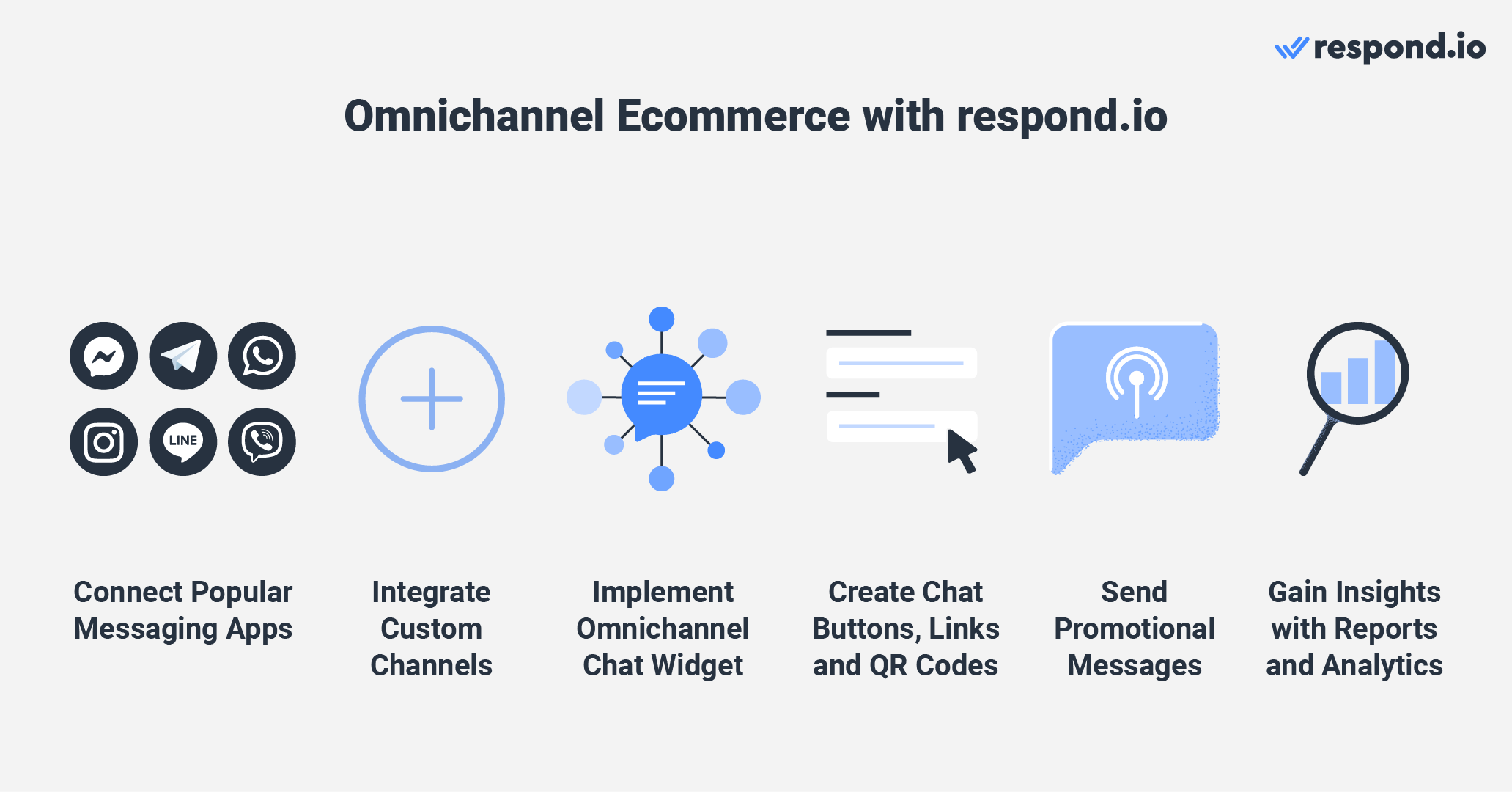
Here, discover how businesses can benefit from using respond.io to improve their communication channels and customer support.
Omnichannel Commerce: Centralize All Popular Channels in One Place
Respond.io is an omnichannel inbox for channels like WhatsApp, Facebook Messenger, Telegram and Viber. It lets ecommerce businesses handle all inquiries in one place, no matter which channels customers use.
This saves time and resources while also making sure that customers receive fast and effective communication.
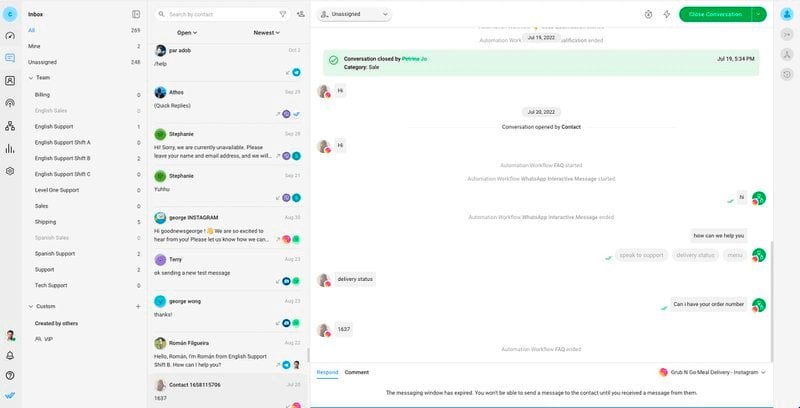
Moreover, respond.io allows you to recognize returning customers on any channel, enabling ecommerce businesses to track interactions across channels and offer personalized service. This enhances the omnichannel experience, increasing customer satisfaction and retention.
Omnichannel Ecommerce Platform: Integrate Custom Channels like In-app Chat, Chats from Ecommerce Platforms and More
Respond.io offers flexible integration with over 5,000 applications, including popular e-commerce platforms like Shopify, Magento, BigCommerce, and WooCommerce. Businesses can manage all customer conversations and data on a single platform, as well as automate messages and more.
Additionally, respond.io integrates with CRMs and other tools like Hubspot and Salesforce, allowing for the creation of deals and tickets or retrieving and updating data while chatting with customers.
Furthermore, its custom channel integration allows e-commerce businesses to connect any custom channel with an open API to the platform. This includes proprietary messaging apps or an e-commerce platform's native inbox, such as Lazada's chat inbox.
Omnichannel Commerce: Offer Customers Flexibility with an Omnichannel Chat Widget
Respond.io’s omnichannel chat widget presents all connected channels in a single collapsible widget, enabling customers to contact businesses through their preferred channels easily.
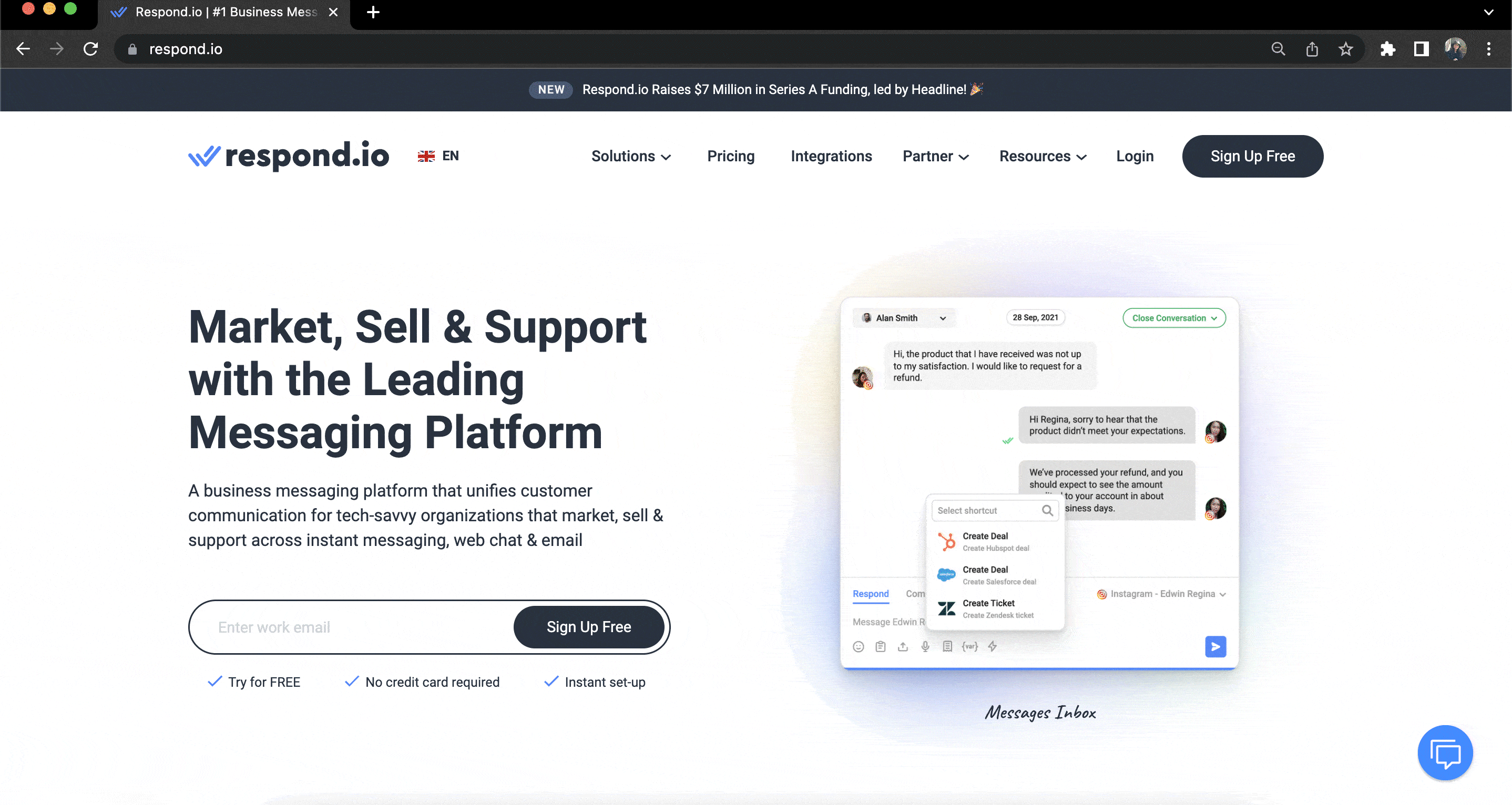
Messaging apps provide more reliable customer contact information than web chat, as website visitors can be anonymous or provide fake data. Businesses can save these contacts in their lists to identify them in future interactions or target them in promotional messages.
Omnichannel Ecommerce Platform: Use Chat Buttons, Links and QR Codes to Drive Engagement
Respond.io helps businesses facilitate cross-channel communication so customers can reach them through various touchpoints. For instance, businesses can effortlessly turn social media followers into WhatsApp contacts by adding WhatsApp chat buttons on Facebook or Instagram.
In addition, businesses can encourage engagement by sharing chat links in digital spaces or displaying QR codes on their website or physical stores. This unified shopping experience bridges physical and digital channels, letting customers talk to businesses on their preferred channels.
Omnichannel Commerce: Send Promotional Messages on Multiple Channels
With respond.io's Broadcast Module, businesses can easily send or schedule targeted broadcast messages across multiple channels.
Moreover, integrations with platforms such as Shopify, WooCommerce, and Magento allow businesses to trigger automated messages in response to events or customer actions. This includes sending timely messages such as drip campaigns, abandoned cart messages, order confirmations, delivery updates and more.
Omnichannel Ecommerce: Boost Retail Sales with Reporting Insights
The Reports Module on respond.io offers insights into conversations and agent performance. It helps businesses identify areas for improvement, such as knowledge gaps or messaging inefficiencies, and develop strategies to optimize their customer interactions and drive growth.
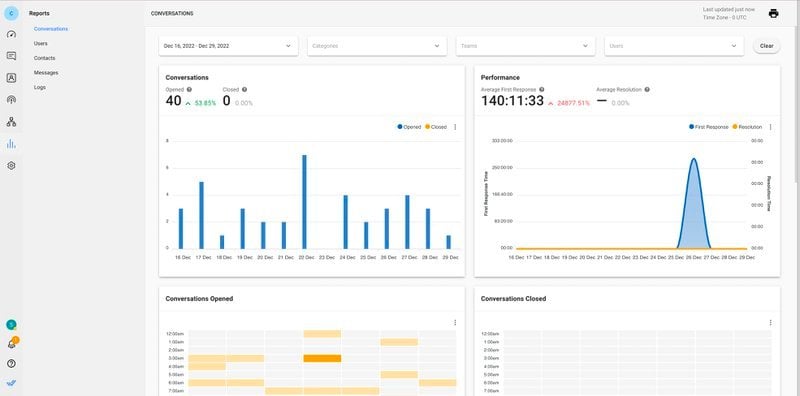
Omnichannel ecommerce has become an essential strategy for online retailers. By integrating all channels, businesses can provide a seamless and consistent shopping experience across all touchpoints. If you're looking to take your business to the next level, sign up for our free trial today!
Turn customer conversations into business growth with respond.io. ✨
Manage calls, chats and emails in one place!
Further Reading
Interested to learn more about how your business can benefit from an omnichannel approach? You may find these articles helpful:






































 Electronics
Electronics Fashion & Apparel
Fashion & Apparel Furniture
Furniture Jewelry and Watches
Jewelry and Watches
 Afterschool Activities
Afterschool Activities Sport & Fitness
Sport & Fitness
 Beauty Center
Beauty Center Dental Clinic
Dental Clinic Medical Clinic
Medical Clinic
 Home Cleaning & Maid Services
Home Cleaning & Maid Services Photography & Videography
Photography & Videography
 Car Dealership
Car Dealership
 Travel Agency & Tour Operator
Travel Agency & Tour Operator




